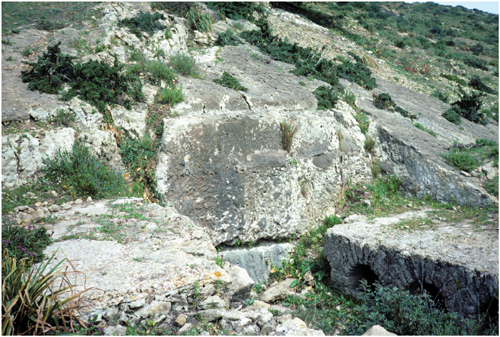REMNANTS OF THE GODS
REMNANTS OF THE GODS
A Visual Tour of Alien Influence in
Egypt, Spain, France, Turkey, and Italy
By Erich von Dniken

Copyright 2014 by Erich von Dniken
All rights reserved under the Pan-American and International Copyright Conventions. This book may not be reproduced, in whole or in part, in any form or by any means electronic or mechanical, including photocopying, recording, or by any information storage and retrieval system now known or hereafter invented, without written permission from the publisher, The Career Press.
REMNANTS OF THE GODS
Edited and Typeset by Diana Ghazzawi
Cover illustration by noir33
Cover design by Howard Grossman/12E Design
Printed in the U.S.A.
Photo credits: Images 36 and 38, Albert Wyss; Images 5559, Hartwig Hausdorf; Image 70, Peter Hentschel; Images 129, 149, 175177 Ali Zarei; Image 155, Sandro Vannini; Images 156157, Dassault Systmes. All other images Erich von Dniken, CH-3803-Beatenberg/Schweiz
To order this title, please call toll-free 1-800-CAREER-1 (NJ and Canada: 201-848-0310) to order using VISA or MasterCard, or for further information on books from Career Press.

The Career Press, Inc.
220 West Parkway, Unit 12
Pompton Plains, NJ 07444
www.careerpress.com
www.newpagebooks.com
Library of Congress Cataloging-in-Publication Data
CIP Available Upon Request
LETTER TO MY READERS
At some point in the obscure churning stew of prehistory, civilisations were at work on earth about which we do not have the faintest idea. Where did they come from? Where did they go? Why did they leave unfathomable buildings behind which make us shake our heads when we look at their ruins? What was actually going on unknown millennia ago? Why did the people of those times do what they did? Whom did they serve? Who directed them? Who were their gods? Why is no writing found either inside or outside their stone marvels? After all, at least the architects of the time must have had command of some form of writing. Without it, extensive complexes are not conceivable. What complexes? Whatyou may well ask!am I going on about?
We are talking about buildings without history, cultures about which we know nothing, although they have left conspicuous traces behind. This applies not only to the stone circles and subterranean complexes, but also the large pyramids of Egypt. Little of what people try to tout as serious scientific thinking is correct. Scratch the surface, and we are left with unbridgeable contradictions and an earth-shattering naivety among the experts. On top of that, we have something simply inconceivable, something which should not existand yet covers our landscape. Demonstrable, measurable, checkable for everyone. Large parts of Europe lie under a geometric grid: I mean whole chains of original buildings which, without exception, are the same distance from one another, across hundreds of kilometers. These pseudo holy sites were slumbering there as long ago as the Stone Age, planned precisely by someone or other. Shaking our heads, looking the other way, or ignoring them will not make these points disappear off the map. They exist whether it suits the academic and public circus or not, and I appreciate every professor of surveying who finally decided to take a closer look at this incredible reality.
This is another volume in a five-volume series about the impossibilities of prehistory. This book is concerned with the large geographical areas surrounding the Mediterranean and the countries in its orbit. Every volume is intended to have 160200 pictures and 100 pages of text. At the end, that will produce 1,000 pictures and 500 pages of text. The work as a whole should be understood as an updated digest of the wealth of information in many of my books. Repetition is intentional; without it, my new readers would be left dangling. Yetand this is what makes the five-volume series so explosivethe most recent discoveries have brought current knowledge to a boiling point. The contradictions scream to high heaven. The forest of question marks keeps growing.
IMPOSSIBLE BUILDINGS
A hundred kilometers southwest of where the city of Tangier is located in Morocco today, at the western entrance to the Strait of Gibraltar, the Carthaginians in the seventh century BC built an ancient port city. They called it Lixus, the eternal one. But this Lixus was built on top of the gigantic blocks of another, older, Phoenician city called Liks. The Phoenicians, in turn, had settled there as long ago as about 1200 BC. Not on a whim, for the Phoeniciansthe great seafarers of antiquityhad come across the remains of a megalithic civilization in the same place. They made use of that. Those unknown megalithic people, the original builders of what later became Lixus, must have handled the imposing stone blocks as little Jimmy handles his toys. (Images 14) The harbour breakwater was as good as lined with colossal stone blocks, and the ramparts were built of hundreds of huge, partly cut granite rocks. If we want to understand how impossible that is, we should briefly consider that every technology follows a fixed evolutionary pattern. At the beginning, the simple people who have just descended from the trees learn how to handle wood and small stones. Then we get the first modest tools and primitive working of stone. Next comes the dressing of the raw blocks and their planning into larger structures. At length, some sort of transport is invented and tested, followed by the manufacture of fibers into pulleys or similar constructs. Finally, the human masses are divided and organised.




In Lixus, this natural evolution of technology is turned on its head. At the beginning, there was an ancient, unknown culture with the ready-made knowledge about how to work and transport extraordinary stones. Then, at some point in the course of the millennia, came the Phoenicians, followed later by the Carthaginians and, finally, the Romans. All these subsequent civilizations used the ready-made blocks from that unknown mysterious people, who at some point thought up and built this complex. (Carthage itself was totally destroyed by the Romans in 146 BC.)
Thor Heyerdahl, the famous experimental archaeologist, started his Atlantic voyage with the papyrus boat RA north of Lixus, and for good reason: that is where there is the strong flow of the Canary Current which carries vessels to Central America with minimal effort. Heyerdahl had not lost his sense of awe. He wrote about the megaliths of Lixus:
Stones cut in various sizes and shapes, but always with vertical and horizontal sides and corners which fit exactly into one another like the stones of a giant jigsaw puzzle; even when the blocks displayed so many right-angled irregularities that the outlines could have been decagonal and dodecagonal instead of right-angled.
Next page

















